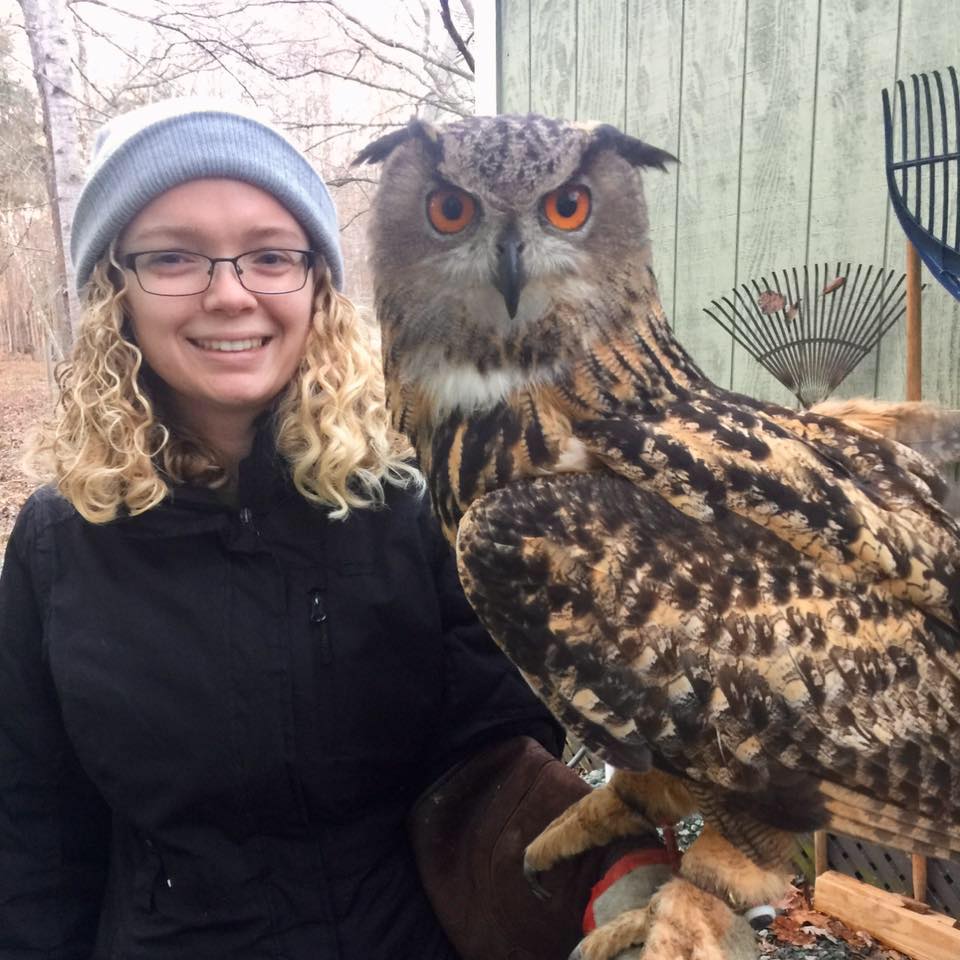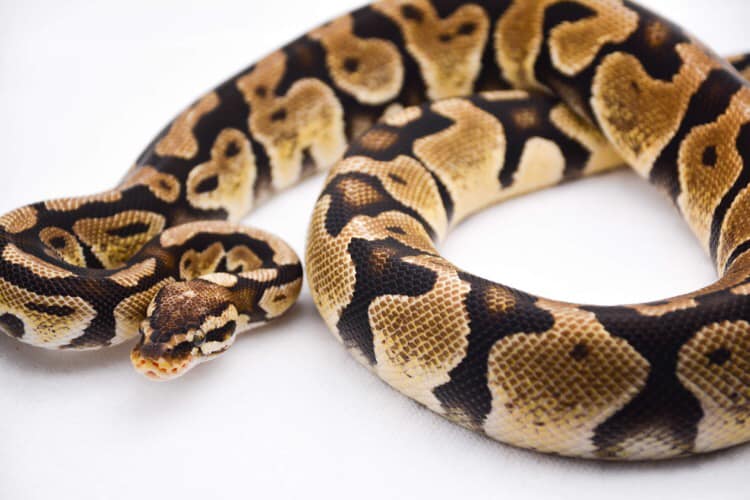
Diversifying Snake Diets
In our experience, snake diets are some of the easiest to feed due to the balanced whole-prey nature of their prey items. Snake diets generally do not have to be supplemented with vitamins or minerals, though of course there are exceptions for certain health issues and special diets. Most keepers exclusively feed their snakes rodents, including rats and mice. While rodents provide an excellent basis for most of the commonly-kept snake species, keepers can provide additional sources of prey to diversify the diet. This can help provide other nutrients as well as enrichment for the snake.
We try to provide a diverse diet for our own ambassador snakes based on the species’ natural history and diet. However, safety is our number one priority; many live foods can carry potentially dangerous parasites, so we stick to frozen/thawed food sources. We also always make sure to source snake food from ethical sources–this means captive-bred, humanely euthanized prey. Check the list below for some safe, alternative food source ideas that are applicable to your snake species.
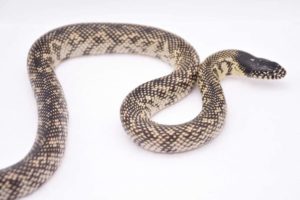 Corn, Rat, King, and Milk Snakes: These snakes often have extremely diverse diets in the wild. For example, kingsnakes often eat other snakes and are immune to pitviper venom. While snakes and lizards may be a large part of their wild diet (Wiseman et al, 2019), we do not feed captive king and milk snakes a reptile-based diet as no humane prey source is available for large-scale commercial use. We choose to incorporate bird eggs and chicks into the diets of these colubrids, as these species will predate upon birds’ nests in the wild and consume eggs, nestlings, and small songbirds (Boback, 2005). In captivity, we mostly feed quail eggs, small quail or quail chicks, and cockerel chicks. Our snakes are definitely most tempted by fresh quail eggs, but many grocery stores also sell small quail eggs that are a good size for most corn and rat snakes. Frozen/thawed chicks and quail can be purchased from RodentPro or other commercial reptile food companies. We definitely feed these species mostly rodents, then chicks, and finally the least amount of eggs. These colubrid species will also usually readily accept African soft fur rats, which are usually more expensive than mice but can be a good rodent alternative to offer occasionally.
Corn, Rat, King, and Milk Snakes: These snakes often have extremely diverse diets in the wild. For example, kingsnakes often eat other snakes and are immune to pitviper venom. While snakes and lizards may be a large part of their wild diet (Wiseman et al, 2019), we do not feed captive king and milk snakes a reptile-based diet as no humane prey source is available for large-scale commercial use. We choose to incorporate bird eggs and chicks into the diets of these colubrids, as these species will predate upon birds’ nests in the wild and consume eggs, nestlings, and small songbirds (Boback, 2005). In captivity, we mostly feed quail eggs, small quail or quail chicks, and cockerel chicks. Our snakes are definitely most tempted by fresh quail eggs, but many grocery stores also sell small quail eggs that are a good size for most corn and rat snakes. Frozen/thawed chicks and quail can be purchased from RodentPro or other commercial reptile food companies. We definitely feed these species mostly rodents, then chicks, and finally the least amount of eggs. These colubrid species will also usually readily accept African soft fur rats, which are usually more expensive than mice but can be a good rodent alternative to offer occasionally.
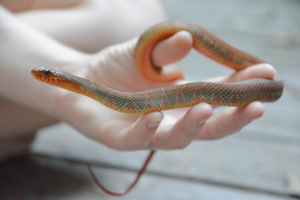 Garter and Water Snakes: The obvious answer to diversifying an aquatic snake’s diet is fish, but keepers should be aware that fish have several potential health issues. First, we do not recommend feeding any live fish, as they can carry parasites such as trematode flukes, cestode tapeworms, and nematodes that can be transferred to your snakes (de la Navarre, 2011). Garter snakes especially are prone to Rhabdias lungworm infections, which can encyst in the lungs and tunnel underneath the skin, causing subcutaneous lesions (Langford & Janovy, 2005). Aquatic snakes often have much shorter lifespans than other wild snakes, and diet is potentially a reason why. If you can breed a clean colony of fish and do regular parasite testing to ensure that your fish are parasite-free, then live fish may be an option. Guppies and platies are both a safe option nutritionally if a clean colony can be found. Secondly, fish often contain thiaminase, an enzyme that destroys thiamine, or vitamin B1. Snakes fed fish with high thiaminase levels can develop severe neurological issues due to vitamin B1 deficiencies (Lichtenberger). This is why goldfish, among many other species, should never be fed to snakes.
Garter and Water Snakes: The obvious answer to diversifying an aquatic snake’s diet is fish, but keepers should be aware that fish have several potential health issues. First, we do not recommend feeding any live fish, as they can carry parasites such as trematode flukes, cestode tapeworms, and nematodes that can be transferred to your snakes (de la Navarre, 2011). Garter snakes especially are prone to Rhabdias lungworm infections, which can encyst in the lungs and tunnel underneath the skin, causing subcutaneous lesions (Langford & Janovy, 2005). Aquatic snakes often have much shorter lifespans than other wild snakes, and diet is potentially a reason why. If you can breed a clean colony of fish and do regular parasite testing to ensure that your fish are parasite-free, then live fish may be an option. Guppies and platies are both a safe option nutritionally if a clean colony can be found. Secondly, fish often contain thiaminase, an enzyme that destroys thiamine, or vitamin B1. Snakes fed fish with high thiaminase levels can develop severe neurological issues due to vitamin B1 deficiencies (Lichtenberger). This is why goldfish, among many other species, should never be fed to snakes.
Fish can provide great enrichment and dietary alternatives, but be sure to choose parasite-free F/T sources and thiaminase-free fish species. Silversides are a type of frozen smelt sold in many pet stores, and aquatic snakes will often readily take F/T silversides. Please note, not all species of smelt are safe–the “Sally’s Silversides” brand are. Our favorite grocery-store fish to offer include cuts of trout and tilapia, but other thiaminase-free fish species include bass, bluegill, crappie, perch, walleye, salmon, flounder, halibut, cod, haddock, and mackerel (DeGregorio, 2014). Of course, feeding solely fish filets will be devoid of many vitamins and minerals generally found in organ meats and bone, so we mostly feed whole-prey rodents and feed smaller amounts of fish as dietary enrichment. Silversides are great because they are whole-prey, but most of the other commercially-available fish are too large for snakes to eat whole.
While many aquatic snakes do eat amphibians in the wild, we choose to avoid feeding amphibian sources due to potential toxins and parasites. Cestode parasites are common in amphibians and can survive being frozen, so unless the amphibian meat is being cooked, it still may be unsafe for consumption (Tapeworm, 2021). Additionally, wild amphibians such as salamanders, newts, toads, and tree frogs have poisons that can harm your snake. Finally, we have not found birds or bird eggs to be a preferred diet item for our aquatic snakes. While the garter snakes are usually too small to take any chicks, the larger water snakes tend to refuse F/T chick offerings.
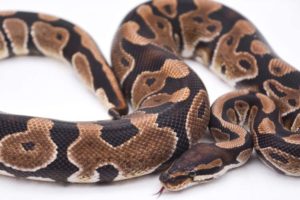 Ball Pythons: Like most pythons, ball pythons have “heat pits,” or infrared sensing pits on their lips that allow them to sense objects with high heat levels. Therefore, this species likely evolved to hunt and eat endotherms such as birds and mammals, who have very high body temperatures. One older study shows that male ball pythons may eat a significant percentage of birds as part of their wild diet, while female ball pythons eat primarily small mammals (Luiselli & Angelici, 1998). We offer rodents as the majority dietary source, including mice, rats, and African soft fur rats. Smaller and younger ball pythons can eat mice and ASF rats, but larger ball pythons should eat larger meals more appropriate for their size, including larger rats. We do offer chicks, small chickens, and quail to ball pythons, but our ambassador female ball python usually refuses birds and vastly prefers rodent meals.
Ball Pythons: Like most pythons, ball pythons have “heat pits,” or infrared sensing pits on their lips that allow them to sense objects with high heat levels. Therefore, this species likely evolved to hunt and eat endotherms such as birds and mammals, who have very high body temperatures. One older study shows that male ball pythons may eat a significant percentage of birds as part of their wild diet, while female ball pythons eat primarily small mammals (Luiselli & Angelici, 1998). We offer rodents as the majority dietary source, including mice, rats, and African soft fur rats. Smaller and younger ball pythons can eat mice and ASF rats, but larger ball pythons should eat larger meals more appropriate for their size, including larger rats. We do offer chicks, small chickens, and quail to ball pythons, but our ambassador female ball python usually refuses birds and vastly prefers rodent meals.
 Boa Constrictors: Boa constrictors have been observed eating a high percentage of birds in the wild, in some cases more often than mammals (Boback, 2005; Quick et al, 2005). We still feed mostly rats, as they are large enough to be an appropriately-sized food source, though young boas can also get mice and ASF rats. We offer chicks, chickens, and quail to diversify boa diets, and birds are usually taken quite readily. While some keepers also offer rabbits, a food item this large should only be offered to exceptionally large individuals such as female true red tails (B. constrictor not B. imperator) and care should be taken to prevent obesity with larger food items.
Boa Constrictors: Boa constrictors have been observed eating a high percentage of birds in the wild, in some cases more often than mammals (Boback, 2005; Quick et al, 2005). We still feed mostly rats, as they are large enough to be an appropriately-sized food source, though young boas can also get mice and ASF rats. We offer chicks, chickens, and quail to diversify boa diets, and birds are usually taken quite readily. While some keepers also offer rabbits, a food item this large should only be offered to exceptionally large individuals such as female true red tails (B. constrictor not B. imperator) and care should be taken to prevent obesity with larger food items.
References
Boback, S. (2005). Natural History and Conservation of Island Boas (Boa constrictor) in Belize. Copeia, 2005(4), 880-885.
DeGregorio, B. et al. (2014). Snake predation on North American bird nests: culprits, patterns and future directions. Journal of Avian Biology, 45(4), 325-333.
De la Navarre, B. (2011). Common parasitic diseases of reptiles & amphibians (Proceedings). Dvm360.
Langford, G., and J. Janovy Jr. (2009). Comparative Life Cycles and Life Histories of North American Rhabdias Spp. (Nematoda: Rhabdiasidae): Lungworms from Snakes and Anurans. The Journal of Parasitology, 95(5), 1145-1155.
Lichtenberger, M. Thiaminase and its role in predatory pet fish (and other piscivores) nutrition. Wet Web Media.
Luiselli, L. and F. M. Angelici. (1998). Sexual size dimorphism and natural history traits are correlated with intersexual dietary divergence in royal pythons (Python regius) from the rainforests of southeastern Nigeria. Italian Journal of Zoology, 65(2), 183-185.
Quick, J., Reinert, H., de Cuba, E., and R. Odum. (2005). Recent Occurrence and Dietary Habits of Boa constrictor on Aruba, Dutch West Indies. Journal of Herpetology, 39(2), 304-307.
Tapeworm infection. (2021). Mayo Clinic > Patient Care and Health Information > Diseases and Conditions.
Wiseman, K., Greene, H., Koo, M., and D. Long. (2019). Feeding ecology of a generalist predator, the California kingsnake (Lampropeltis california): why rare prey matter. Herpetological Conservation and Biology, 14(1), 1-30.
